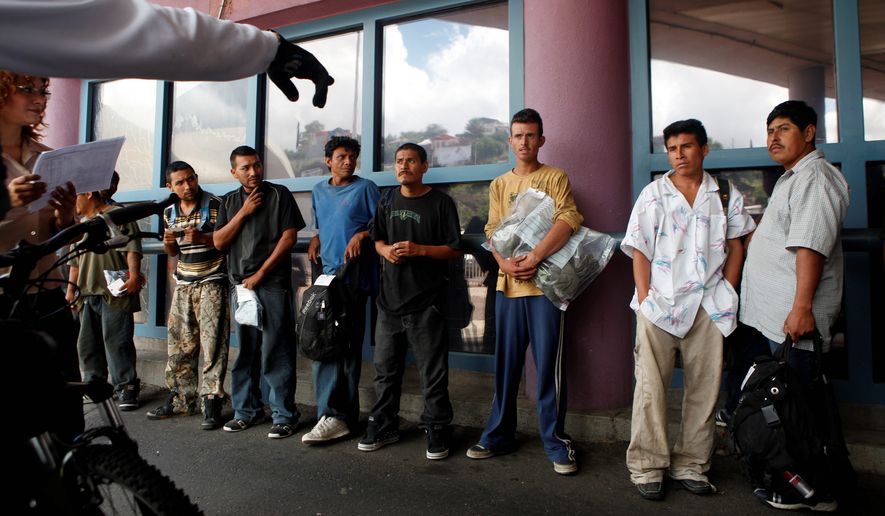The Obama administration has cut deportations back to the level they were before President George W. Bush’s end-of-term surge, raising questions about whether he is skirting the law with his claim of prosecutorial discretion.
Administration officials have told Congress repeatedly that their budget gives them the resources to deport about 400,000 illegal immigrants a year, but numbers reported by The Associated Press last week suggested they were on pace to deport about 320,000 this year. Those figures track with what The Washington Times projected in April.
“Where is the money being wasted?” said Jessica Vaughan, policy studies director at the Center for Immigration Studies.
She said the numbers puncture the administration’s assertion that it is deporting all the people it can, given its budget.
“If they are underperforming in terms of numbers, how can there be an argument for further scaling back deportations, if they are already removing fewer people than they could be?” she said.
According to the numbers obtained by AP, the administration had deported 258,608 people as of July 28. That is a 20 percent drop from 2013 and a 25 percent drop from 2012’s record pace, and leaves the government on pace to deport about 320,000 in the fiscal year that ends Sept. 30.
SEE ALSO: Obama decision to delay deportations infuriates immigrants rights groups
Given that Homeland Security Department officials say they have money to deport about 400,000, the drop is stunning.
Critics say it’s more evidence of President Obama’s unilateral decisions to carve a number of illegal immigrants out of any danger of deportation — what they refer to as executive amnesty.
Obama defenders say he would never be able to deport the 11.5 million illegal immigrants estimated to be in the U.S., so picking and choosing makes sense.
U.S. Immigration and Customs Enforcement, the Homeland Security agency responsible for deportations, cautioned that the fiscal year isn’t completed so it’s too early to make judgments. Still, the agency said it’s trying to stick to its priorities.
“ICE remains focused on smart and effective immigration enforcement that prioritizes the removal of convicted criminals and recent border entrants,” the agency said in a statement.
Stephen Legomsky, a law professor at Washington University in St. Louis, said the number of deportations may have dropped for a number of reasons, and it doesn’t mean the administration is ignoring its duty to the law.
SEE ALSO: The cost to educate young illegal immigrants over $761 million - a bill for all 50 states
One issue is the increasing number of localities that refuse to cooperate with ICE, meaning they won’t hold immigrants for agents to pick up. That has reduced the number of easy deportations.
Another factor could be the rise in deportations of Central Americans rather than Mexicans, who used to represent the vast majority of deportees. Mr. Legomsky, who was chief counsel at U.S. Citizenship and Immigration Services, another Homeland Security agency, said it’s costlier to deport those from Central America, who have to be flown back to the interior of their countries, rather than bused across the border into Mexico.
“Different deportations cost different amounts of money,” he said. “The figure of 400,000, I assume, was accurate at the time [ICE Director John] Morton announced it, but circumstances changed.”
Mr. Morton was citing the 400,000 figure up until his departure as head of ICE last year. As homeland security secretary, Janet A. Napolitano also used the figure in testimony to Congress.
Central Americans began surging as a percentage of those removed by 2012, though it gained public attention this year when children and families from Honduras, Guatemala and El Salvador began to be apprehended in exceptionally high numbers.
Ms. Vaughan doubted the cost explanation, saying that when deportations were at about 400,000 a year in 2011 and 2012, federal authorities had a program that transferred hundreds of thousands of Mexican illegal immigrants to border points hundreds of miles from where they entered.
The program, which was designed to deter repeat crossings, has been scaled back as the Central American surge has grown. That suggests money is available to cover the costs of transporting Central Americans.
The spike in children and families drew renewed attention to border security and forced Mr. Obama to back off his vow to expand his nondeportation policies. The president now says he will act after the November elections, when his moves no longer pose a political danger to Democrats running in key Senate races.
Congressional Republicans have urged Mr. Obama to scrap his plans altogether, arguing that carving more illegal immigrants out of danger of deportation will encourage more to come.
On the other side of the debate, some immigrant rights activists doubt Mr. Obama will ever make good on his promise.
But Mr. Legomsky, who was one of the lawyers involved in crafting the 2012 policy that allowed young adult illegal immigrants to earn “deferred action” — a stay of deportations and work permits allowing them to earn a living in the U.S. — said he thinks Mr. Obama will follow through. He also said the president has the legal authority to draw a fairly broad net for halting deportations.
“I personally would be surprised if the president doesn’t deliver on his promise to deliver significant humanitarian relief,” the professor said.
• Stephen Dinan can be reached at sdinan@washingtontimes.com.




Please read our comment policy before commenting.